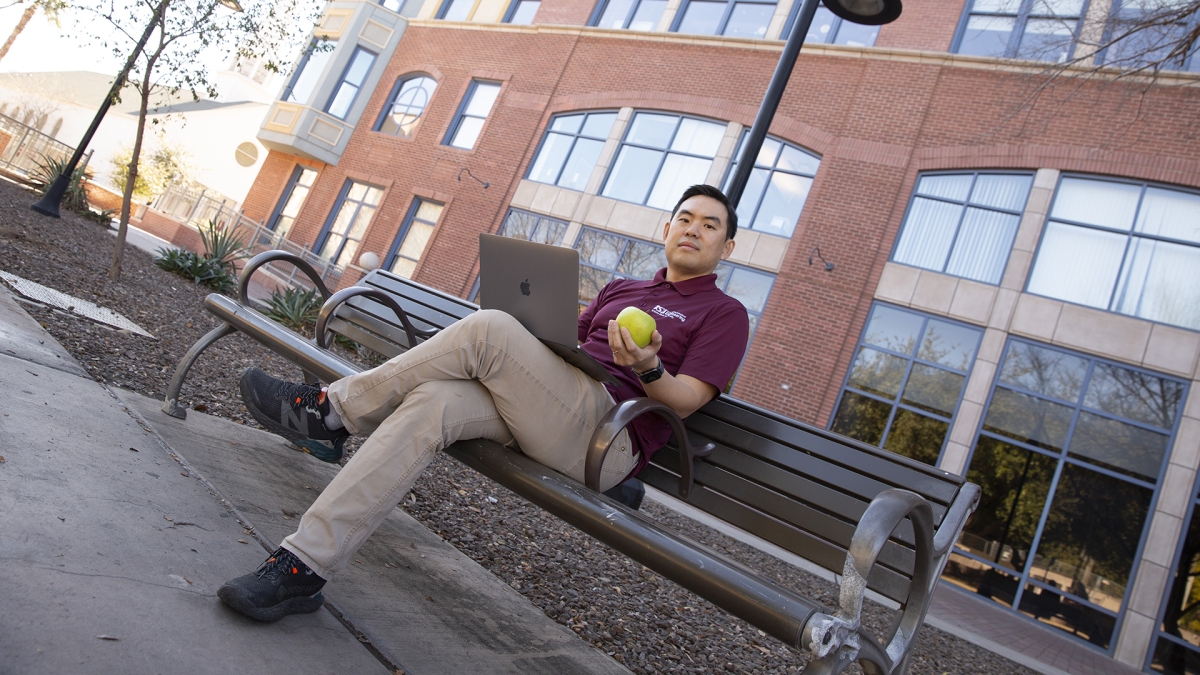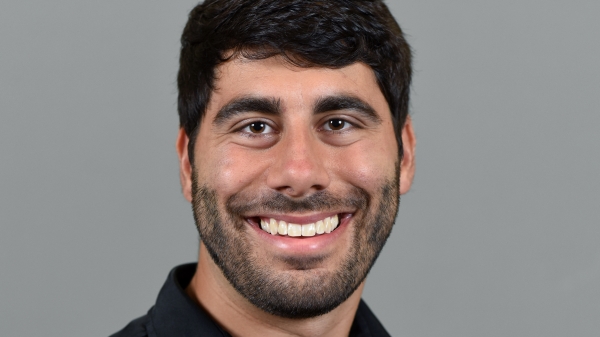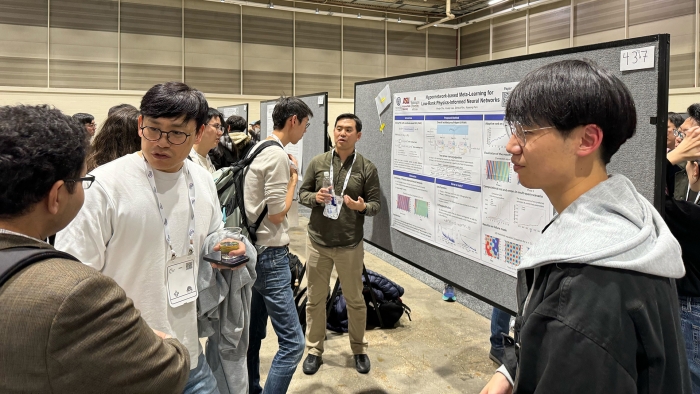New AI for a new era of discovery
ASU faculty member earns NSF CAREER Award to develop deep learning tools

Kookjin Lee, an assistant professor of computer science and engineering in the Ira A. Fulton Schools of Engineering at Arizona State University, has received a Faculty Early Career Development (CAREER) Award from the National Science Foundation to create a machine learning system that will help discover new scientific laws. Photo by Erika Gronek/ASU
As the legend goes, in 1665, Sir Isaac Newton sat in his garden at Woolsthorpe Manor in England and looked on as a lone apple dropped from a tree branch, falling straight down. This chance encounter led Newton to begin the work that led to his famous theory of gravity.
While this idea would shape the modern world, it took Newton more than 20 years to publish it in his book, “Philosophiæ Naturalis Principia Mathematica,” and it would be another century before his theories were tested in a laboratory setting.
In a future imagined by Kookjin Lee, Newton will not be a man but rather a network of computers that have watched thousands and thousands of apples fall to the ground and will use artificial intelligence, or AI, to learn from what it observed.
Lee is an assistant professor of computer science and engineering in the School of Computing and Augmented Intelligence, part of the Ira A. Fulton Schools of Engineering at Arizona State University.
He received a 2024 National Science Foundation Faculty Early Career Development Program (CAREER) Award to develop algorithms — the set of instructions that computers implement to do their work — that will pioneer an advanced kind of AI called "scientific machine learning."
Today, people are becoming more familiar with machine learning. Facial recognition software, like applications that learn to recognize photos of your family members and organize their pictures into digital albums, is a common type of AI.
Lee explains that scientific machine learning is different.
“Machine learning algorithms typically capture a lot of historical information and then use the data patterns to make predictions about the future,” he says. “With scientific machine learning, the software is told about the world’s physical rules. The system should know more about what to expect because it should know what is possible.”
In the digital photo album example, current software might learn to recognize photos of a user’s mother and group them together. But the user could also upload an image of their pet turtle and identify it as “Mom.” The application would find other pictures of the pet and put them in Mom’s photo gallery. A system using scientific machine learning would know that the turtle could not possibly be the user’s mother.
What goes up must come down
Lee’s algorithms would combine a level of awareness of key facts about the natural sciences, especially physics, chemistry and biology, with huge amounts of data. Because of the size of the datasets and the complexity of the information being analyzed, this type of AI is also called deep machine learning.
“I’m trying to introduce these deep learning models to large amounts of observational data about complex physical phenomena in the hope of discovering new scientific laws,” Lee says.
The result could be groundbreaking advancements made in a matter of months or years — not centuries.
The work is generating excitement among Lee’s colleagues. Nat Trask, an associate professor of mechanical engineering and applied mechanics at the University of Pennsylvania who served as Lee’s postdoctoral research supervisor, says that the tools being developed are of particular value.
“Lee’s work is an important link between contemporary machine learning and techniques from applied mathematics,” Trask says. “He obtains a framework that can reliably develop very deep networks which perform well. He extends these techniques to material discovery problems where one needs to fuse data coming from a range of scientific experiments.”
While this will be exciting news to physicists who must analyze enormous amounts of data to draw helpful conclusions, Lee also believes his work will have many real-world applications. He sees it as being especially useful for the study of fluid dynamics. In the aviation and automotive industries, his tools could create safer or more aerodynamic products.
He also notes that the potential for discoveries in thermodynamics is especially appealing to research organizations such as Sandia National Laboratory, where Lee did postdoctoral work.
Ross Maciejewski, director of the School of Computing and Augmented Intelligence, says that Lee’s research will be invaluable to both the Fulton Schools and the scientific community at large.
“What’s so exciting about Lee’s work is that it represents an important interdisciplinary approach to the development of new AI technology,” Maciejewski says. “This award funds an innovative collaboration between computer science and the physical sciences.”
A career with inertia
Lee’s current work builds on his prior research supported by the NSF. In 2022, he received a grant to use deep machine learning to study how disinformation on social media might lead to anti-Asian racial bias and spikes in real-world hate crimes. While this is a different research topic than what his new CAREER Award is supporting, Lee sees a synergy between his past and present projects.
“I am trying to develop scientific machine algorithms that better explain what we are seeing in real life,” he says.
His CAREER Award project proposal also includes plans to provide opportunities for historically underserved students. Both graduate and undergraduate students will be able to participate in research opportunities in Lee’s lab at ASU.
For Lee, life at the university is a family affair. After earning his doctoral degree from the University of Maryland and doing his postdoctoral work, he joined the ASU faculty team along with his wife, Heewon Chae, an assistant professor in the W. P. Carey School of Business.
“I was impressed by all the recruiting being done at ASU as part of efforts to build a world-class computer science program,” Lee says.
The CAREER Award provides a blueprint for Lee’s research over the next five years.
“Scientific machine learning is considered a relatively new area,” Lee says. “There are many ideas that have not been explored yet, and I am looking forward to the future.”
Trask agrees that the future is bright for these endeavors, saying, “Lee is tremendously hardworking and has a remarkable talent for collaborating with people whose work spans across a range of theoretical and experimental fields.”
More Science and technology

ASU researchers develop special microphone to verify human speech
Deepfakes have become a large societal concern with the advent of video and audio content generated by artificial intelligence, or AI. A deepfake is a convincing imitation that blurs the lines…

Leading students toward a future of renewable energy
Nicholas Rolston, assistant professor in the School of Electrical, Computer and Energy Engineering, one of the Ira A. Fulton Schools of Engineering at Arizona State University, has found his passion…

SPARCS mission spacecraft bus delivered to ASU for final assembly
The Arizona State University team that is building the NASA-funded Star-Planet Activity Research CubeSat, or SPARCS, cleared a major milestone this week — receiving its spacecraft bus at the School…
